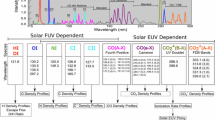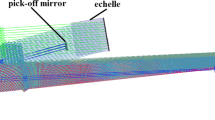Abstract
The Ultraviolet-Visible Spectrometer (UVS) instrument, which flew on the Lunar Atmosphere and Dust Environment Explorer (LADEE) spacecraft (SC), was one of three science instruments used to characterize the lunar exosphere. UVS is a point spectrograph operating between 230–810 nm and used its two optical apertures to make observations of the exosphere just above the surface at a range of local times and altitudes, as well as making solar occultation measurements at the lunar sunrise terminator. The instrument was led out of NASA Ames Research Center with primary hardware being provided by Draper Laboratories. Final instrument integration, testing and operations were performed at NASA Ames. Over the course of the 140-day LADEE mission UVS acquired more than 1 million spectra, providing a unique data set for lunar exosphere gasses and dust.























Similar content being viewed by others
References
A. Bhardwaj, S. Raghuram, A coupled chemistry-emission model for atomic oxygen green and red-doublet emissions in the comet C/1996 B2 Hyakutake. Astrophys. J. 748, 18 (2012)
B.J. Buratti, M.D. Hicks, J. Nettles, M. Staid, C.M. Pieters, J. Sunshine, J. Boardman, T.C. Stone, A wavelength-dependent visible and infrared spectrophotometric function for the Moon based on ROLO data. J. Geophys. Res. 116, E00G03 (2011)
R.P. Cageao, Y.L. Ha, Y. Jiang, M.F. Morgan, Y.L. Yung, S.P. Sander, Calculated hydroxyl A2Σ→X2Π (0, 0) band emission rate factors applicable to atmospheric spectroscopy. J. Quant. Spectrosc. Radiat. Transf. 57, 703–717 (1997)
K. Chance, R.L. Kurucz, An improved high-resolution solar reference spectrum for earth’s atmosphere measurements in the ultraviolet, visible, and near infrared. J. Quant. Spectrosc. Radiat. Transf. 111, 1289–1295 (2010)
D.H. Crider, R.R. Vondrak, The solar wind as a possible source of lunar polar hydrogen deposits. J. Geophys. Res. 105(E11), 26773 (2000)
D.R. Criswell, Horizon-glow and the motion of lunar dust, in Photon and Particle Interaction in Space, ed. by R.J.L. Grard (Reidel, Dordrecht, 1973), p. 545
K. Ennico, M. Shirley, A. Colaprete, L. Osetinsky, The Lunar Crater Observation and Sensing Satellite (LCROSS) payload development and performance in flight. Space Sci. Rev. 167, 23–69 (2012)
P.D. Feldman, D.A. Glenarb, T.J. Stubbs, K.D. Retherford, G.R. Gladstone, P.F. Miles, T.K. Greathouse, D.E. Kaufmann, J.W. Parker, S.A. Stern, Upper limits for a lunar dust exosphere from far-ultraviolet spectroscopy by LRO/LAMP. Icarus 233, 106–113 (2014)
B.C. Flynn, S.A. Stern, A spectroscopic survey of metallic species abundances in the lunar atmosphere. Icarus 124(2), 530–536 (1996)
D.A. Glenar, T.J. Stubbs, J.E. McCoy, R.R. Vondrak, A reanalysis of the Apollo light scattering observations, and implications for lunar exospheric dust. Planet. Space Sci. 59(14), 1695–1707 (2011)
M. Horanyi, S. Gagnard, D. Gathright, E. Gruen, D. James, S. Kempf, M. Lankton, R. Srama, Z. Sternovsky, J. Szalay, The Dust Environment of the Moon as Seen by the Lunar Dust Experiment (LDEX), in 45th Lunar and Planetary Science Conference, Held 17–21 March, 2014 at The Woodlands, Texas. LPI Contribution No. 1777 (2014), p. 1303
R.R. Hodges Jr., Methods for Monte Carlo simulation of the exospheres of the Moon and Mercury. J. Geophys. Res. 85(A1), 164–170 (1980)
M. Kagitani, M. Taguchi, A. Yamazaki, I. Yoshikawa, G. Murakami, K. Yoshioka, S. Kameda, S. Okano, Variation in lunar sodium exosphere measured from lunar orbiter SELENE (Kaguya). Planet. Space Sci. 58(12), 1660–1664 (2010)
The Lunar Exploration Roadmap: Exploring the Moon in the 21st Century: Themes, Goals, Objectives, Investigations, and Priorities, Lunar Exploration Analysis Group (LEAG) (2011)
T.E. Madey, B.V. Yakshinskiy, V. Ageev, R.E. Johnson, Desorption of alkali atoms and ions from oxide surfaces—Relevance to origins of NA and K in atmospheres of Mercury and the moon. J. Geophys. Res. 103, 5873 (1998)
P. Mahaffey et al., The neutral mass spectrometer on the lunar atmosphere and dust environment explorer mission. Space Sci. Rev. (2014). doi:10.1007/s11214-014-0043-9
M. Matta, S. Smith, J. Baumgardner, J. Wilson, C. Martinis, M. Mendillo, The sodium tail of the Moon. Icarus 204, 409–417 (2009)
J.E. McCoy, D.R. Criswell, Evidence for a high latitude distribution of lunar dust, in Proc. Lunar Sci. Conf. 5th (1974), p. 2991
A.D. Michael, U. Fink, A.B. Schultz, Spatial distribution of H2O+ in Comet P/Halley. Icarus 86, 152–171 (1990)
National Research Council—Committee on the Scientific Context for Space Exploration. The National Academies Press (2003)
National Research Council—Decadal Survey, Visions and Voyages for Planetary Science in the Decade 2013–2022. National Academies Press (2011)
A.E. Potter, R.M. Killen, T.H. Morgan, Variation of lunar sodium during passage of the Moon through the Earth’s magnetotail. J. Geophys. Res. 105(E6), 15073–15084 (2000)
J.J. Rennilson, D.R. Criswell, Surveyor observations of lunar horizon glow. The Moon 10, 121 (1974)
M. Sarantos, R.M. Killen, A.S. Sharma, J.A. Slavin, Influence of plasma ions on source rates for the lunar exosphere during passage through the Earth’s magnetosphere. Geophys. Res. Lett. 35, L04105 (2008)
M. Sarantos, R.M. Killen, S.A. Surjalal, J.A. Slavin, Sources of sodium in the lunar exosphere: Modeling using ground-based observations of sodium emission and spacecraft data of the plasma. Icarus 205, 364–374 (2010)
M. Sarantos, R.M. Killen, D.A. Glenar, M. Benna, T.J. Stubbs, Metallic species, oxygen and silicon in the lunar exosphere: Upper limits and prospects for LADEE measurements. J. Geophys. Res. 117(A3), A03103 (2012)
The Scientific Context for Exploration of the Moon (SCEM), Committee on the Scientific Context for Exploration of the Moon, Space Studies Board, Division on Engineering and Physical Sciences, National Research Council of the National Academies. The National Academies Press (2007)
A.B. Severny, E.I. Terez, A.M. Zvereva, The measurements of sky brightness on Lunokhod-2. The Moon 14, 123–128 (1975)
A.L. Sprague, R.W. Kozlowski, D.M. Hunten, W.K. Wells, F.A. Grosse, The sodium and potassium atmosphere of the moon and its interaction with the surface. Icarus 96, 27–42 (1992)
K. Stamnes, P. Conklin, A new multi-layer discrete ordinate approach to radiative transfer in vertically inhomogeneous atmospheres. J. Quant. Spectrosc. Radiat. Transf. 31, 273–282 (1984)
S.A. Stern, J.W. Parker, T.H. Morgan, B.C. Flynn, D.M. Hunten, A. Sprague, M. Mendillo, M.C. Festou, NOTE: an HST search for magnesium in the lunar atmosphere. Icarus 127(2), 523–526 (1997)
A.S. Stern, The lunar atmosphere: history, status, current problems, and context. Rev. Geophys. 37, 453 (1999)
T.J. Stubbs, R.R. Vondrak, W.M. Farrell, A dynamic fountain model for lunar dust. Adv. Space Res. 37, 59–66 (2006)
T.J. Stubbs, D.A. Glenar, A. Colaprete, D.T. Richard, Optical scattering processes observed at the Moon: Predictions for the LADEE Ultraviolet Spectrometer. Planet. Space Sci. 58(5), 830–837 (2010)
H.A. Zook, E. McCoy, Large scale lunar horizon glow and a high altitude lunar dust exosphere. Geophys. Res. Lett. 18, 2117 (1991)
Acknowledgements
We are grateful for the opportunity to participate in the LADEE Mission and to all the people who made UVS and flight operations possible. We also appreciate the two reviewers who provided excellent feedback which greatly improved the quality of this paper. This effort was supported by the NASA Science Mission Directorate Lunar Quest Program.
Author information
Authors and Affiliations
Corresponding author
Rights and permissions
About this article
Cite this article
Colaprete, A., Vargo, K., Shirley, M. et al. An Overview of the LADEE Ultraviolet-Visible Spectrometer. Space Sci Rev 185, 63–91 (2014). https://doi.org/10.1007/s11214-014-0112-0
Received:
Accepted:
Published:
Issue Date:
DOI: https://doi.org/10.1007/s11214-014-0112-0




